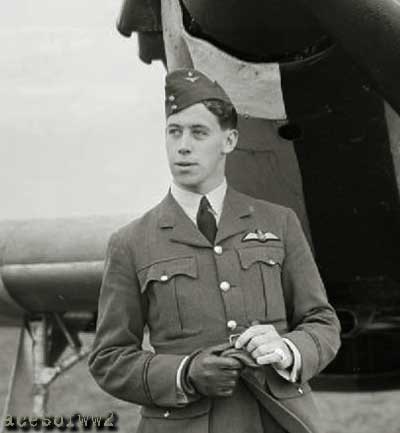_________________________________________________ |
||||||||
The London Gazette , TUESDAY, the 20th of FEBRUARY, 1940 Air Ministry, ROYAL AIR FORCE
Mentioned in Despatches
His Majesty has also been graciously pleased to give orders for the publication of the names of the following officers and airmen who have been mentioned in despatches by Air Officers Commanding-in-Chief :
... Flying Officer E. J. KAIN (39534) ...
_________________________________________________
The London Gazette, FRIDAY, the 29th of MARCH, 1940 Air Ministry, ROYAL AIR FORCE
The KING has been graciously pleased to approve of the undermentioned award in recognition of gallantry displayed in flying operations against the enemy:
Awarded the Distinguished Flying Cross
Flying Officer Edgar James KAIN (39534) - In March, 1940, while on patrol with another aircraft, Flying Officer Kain sighted seven enemy bombers about 5,000 feet above him, and while giving chase well into Germany, he was attacked from behind by an enemy fighter. Showing the finest fighting spirit this officer outmaneuvered the enemy and although his own aircraft was badly damaged he succeeded in bringing the hostile aircraft down. Thick smoke and oil fumes had filled his cockpit and although unable to see his compass, he skillfully piloted his aircraft inside allied lines in spite of being choked and blinded by the smoke.
_________________________________________________
KAIN, D.F.C. Eager to Fight Again
LONDON, 29 March 1940 - (A.A.P.) - The first "ace" of the Royal Air Force, Flying-Officer Edgar (“Cobber”) Kain, aged 21, of New Zealand, was today awarded the D.F.C. for gallantry in operations against the enemy.
Kain was standing by yesterday with the R.A.F. Advanced Force on the Western Front, ready to fly again. A medical order was given, however, that he was not to fly until a week had elapsed.
Kain shot down two German planes in an air battle (reported yesterday), and, for the second time in the war, when his own plane was shot down in flames, he parachuted to safety.
The shrapnel wounds from the guns of the Messerschmitt which shot him down are healing rapidly, and he is little the worse for his adventures.
The ground staff "wrote off" "Cobber" when his blazing plane disappeared into a cloudbank, but he turned up in the mess in a tiny French village that night, his face brick-red from burning oil, his eyebrows singed, bandages on a leg and a hand, and his hair still stained and streaked with oil.
Three Messerschmitts and two - probably three - Dorniers have fallen to this tall, lean New Zealander, who left Wellington two years ago with a Civil "A" licence in his pocket.
He was asked to “come back a second time" when he presented himself before the R.A.F. Medical Board in England, because at the age of 19 he had outgrown his strength. Three months later, the Medical Board passed him as fit for training. He has been flying ever since.
_________________________________________________
Anglo-French Rivalry
2 April 1940 - From Paris, the correspondent of the ‘‘Daily Telegraph” says a scoreboard of British and French pilots’ successes is being carefully kept. The New Zealander, "Cobber” Kain, is at present leading with five certainties, but a friendly French rival, whose name so far has not been revealed, is expected to receive shortly credit for his fifth enemy plane. A sergeant pilot at present heads the French list with three official victories.
_________________________________________________
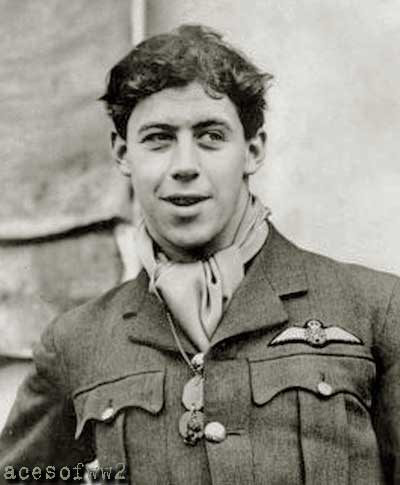 |
R.A.F. HERO WEARS MAORI CHARM
|
_________________________________________________
"COBBER" KAIN ON FIRST LEAVE
(Australian Associated Press) LONDON, April 5. 1940 – “Cobber” Kain, famous New Zealand “ace” of the Royal Air Force, home on his first leave, walked the streets of London with 20 pieces of shrapnel in his left leg and one in his left hand - relics of his most recent battle. Kain, who was seen lunching unobtrusively in a West End restaurant, later went to see a newsreel of himself, and then visited a Sussex farm to see the mother of a comrade who had been killed.
_________________________________________________
First Air Ace
"Cobber- Kain the New Zealand airman, is now referred to in the British press as Britain's first air ace. The “Daily Mail" says, “Every Briton is proud of him with five Nazi planes to his account. They are none the less proud because he is a New Zealander, but why should there be continued anonymity for our home-grown heroes. Why is their identity always hidden? Similar reticence in the last war gave the impression that all the aces were from the Dominions."
Kain, who is at present staying at Peterborough on leave, saw a newsreel of himself and received a copy from the producer.
_________________________________________________
"COBBER" KAIN Affianced to Actress
(Australian Associated Press) LONDON, April 14 - The New Zealand airman, "Cobber" Kain has become affianced to Miss Joyce Phillips, a 23-year-old actress, appearing at the Repertory Theatre, Peterborough.
Miss Phillips said, "Being engaged to an air ace certainly means learning to go to places at high speed. 'Cobber' spent a week dashing between Peterborough to see me, and Chester to see my family, and Birmingham to see friends. He came to the theatre on Friday night, and proposed after the show. We were up at 6 a.m. on Saturday, and dashed to Birmingham to buy the ring. I then raced back for the show, after which I went immediately to London to meet him, because I do not know when he will get another leave. I worry sometimes, but I have the greatest confidence in 'Cobber.' He has as good a chance as the next."
_________________________________________________
First Ace of War
‘Cobber' Kain's Guns Are Deadly Accurate
Young New Zealand Flier Bags Five Nazis; Shot Down Two German Fighters In One Day
By EDWIN S. JOHNSON (Canadian Press Staff Writer), London, 22 April 1940 - Meet the first British air "Ace" of the present war — Flying Officer Edgar (Cobber) Kain, D.F.C., 21-year-old New Zealander, who has become a national hero almost overnight. FIRST TIME HIT After recovering from his latest exploit, the young New Zealander, who stands more than six feet, came to London. |
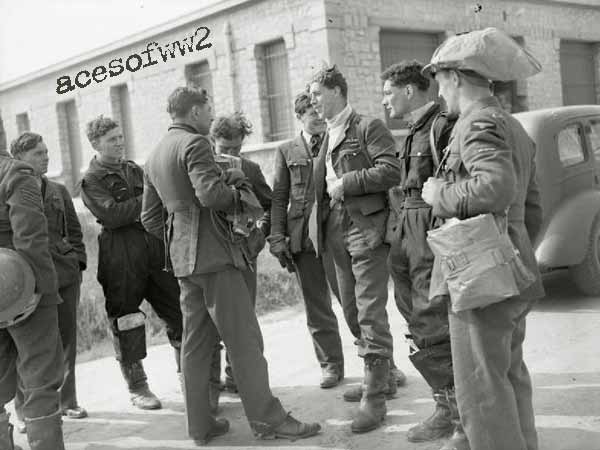 May 1940, France - Having just landed, S/L "Hank" More (back to camera), chats with his pilots outside the Squadron's Ops Building at Reims-Champagne. Facing More, in the white turtle-neck, is F/O "Cobber" Kain. To Kain's right, and slightly behind him, stands F/O "Fanny" Orton. To Orton's right and slightly obscured by More, is F/O "Ginger" Paul and to More's left is Sgt. "Tich" Pyne and standing on Kain's left is P/O V. D. Roe. |
Asked what he thought of the Germans as air fighters, "Cobber" said:
"I can only speak from personal experience and that is, whenever they are in vastly superior numbers the Fritzies don't mind having a scrap. But when we come across them in numbers anywhere equal to our own, they put their noses down and run for home.
"Their usual tactic is to dive on their opponent, fire a burst and scoot away. Another favorite trick is for several of their fighters to engage ours while two or three Messerschmitts hover high above waiting to dive on a British machine which may have become separated from the rest.
"That's how they got me last time."
When off duty "Cobber" has a pastime of his own — pig shooting in the woods near his airdrome in France. He claims to have trained his pet dog to "rustle a pig a mile away."
Kain on April 13 announced his engagement to Miss Joyce Phillips, 23-year-old English actress.
_________________________________________________
BRITISH AIR ACES
Daring Adventures
(Australian Associated Press) LONDON. May 15, 1940 - Flying Officer Les Clisby, South Australian, and "Cobber" Kain, of New Zealand, now share the honor of leading aces in the R.A.F. advanced air-striking force. Clisby, after shooting down a Heinkel 111, landed alongside the machine and captured three German airmen at the point of his revolver. Prior to last week he was credited with five planes, but his total is now 14. Kain’s total to yesterday was eleven, after which it is known he had further successes, which probably made him equal with Clisby.
One fighter squadron alone has bagged 27 enemy machines since May 10, and 39 since the outbreak of the war. All the original pilots of this squadron have shot down at least three.
It is understood that a 27-year-old Adelaide airman, R. W. Bungey, participated in a daring bombing raid which saved a French detachment from being cut off. Bungey has kangaroos painted on the fuselage of his machine, and a koala dangles from its rear gun sight.
The Air Ministry announced that while British bomber aircraft attacked enemy's road and rail approaches to the Dutch and Belgian battle fields, the Whitley and Hampden machines used parachute flares to assist in identifying targets. They encountered heavy air fire. On the Dutch battle field important railway bridges were attacked and a fire was seen to break out following a direct hit from 4000 feet. From these operations all the aircraft returned safely. In almost every engagement R.A.F. fighter aircraft had unhesitatingly attacked formations far larger than their own. In the grim battle now in progress the utmost gallantry and audacity were being shown. In one day's work British fighter pilots inflicted on the enemy at least four times the losses they suffered themselves.
Clisby was KIA May 14th (some say 15th), the day before this article was printed.
_________________________________________________
'Cobber' Kain Will Marry Next Month
LONDON — Flying Officer Edgar "Cobber" Kain — who proposed to actress Joyce Phillips during the run of "The Importance of Being Earnest" at Peterborough, is to be married in July — if he can get leave.
"Wedding provisionally fixed for July" — that was the cable that twenty-year-old Joyce sent to Cobber’s mother in Auckland, New Zealand, recently.
Mrs. Phillips, Joyce’s mother, of Rose Farm, Great Mollington, near Chester, said: "They will be married at Backford church, Great Mollington, and all Cobber’s friends who can get leave will be there.
Joyce will keep her Job with the Peterborough Repertory Company."
When Cobber was on leave in April he stayed with the Phillips’ at Great Mollington. He had won fame before then by bringing down five Nazi planes — and he has probably added considerably to that total by now.
_________________________________________________
FIRST AIR ACE DIES IN ACTION
"Cobber" Kain, Heroic New Zealand Flyer, Is Casualty
27-Year-Old Flier Ranked in Public Mind With Bishop of Canada in Last War
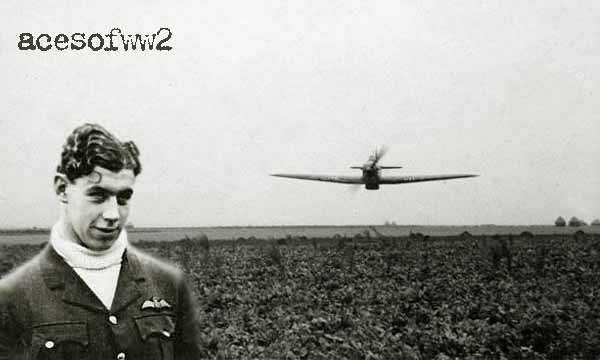 Cobber Kain is seen here doing a low level fly-by or "beating up" the field. It was while doing this (and a slow roll) as he was leaving for England that he crashed and died. |
London, 10 June 1940 — (CP) —The Empire's first air ace of the war, Flying Officer E. J. (Cobber) Kain, unofficially credited with more than 40 German planes shot down in action, has been killed, it was disclosed today.
His death resulted from a flying accident while on duty, not in action. A New Zealander, Kain had recently been named to head a group of pilots "with a bag of 20 or more" enemy planes on roving commissions. Kain was awarded the Distinguished Flying Cross last March for gallantry in attacking, with another plane, seven Nazi bombers, and chasing them into German territory. Previously "Cobber" had shot down five German planes — two Dornier bombers and three Messerschmitt fighters. In one air fight, he had to "bail out" when his machine was shot down. He was wounded by shrapnel in his left leg and hand. Kain, who was a few weeks short of his 23rd birthday, was the first airman to win distinction in France in the present war. While on leave in England last April, Kain announced his engagement to Joyce Phillips, 23-year-old actress. Record Will Inspire Wellington, New Zealand, June 10 — (CP-Reuters) — Prime Minister Peter Fraser said today, the death of Flying Officer E. J. (Cobber) Kain in action has caused the deepest sorrow throughout New Zealand. |
"New Zealanders unite in paying heartfelt tribute to the memory of those brave young men who fought and died that the homeland may survive and resume the ways of peace."
_________________________________________________
“COBBER” KAIN IN FATAL FLYING ACCIDENT
First British Air Ace of the War
11 June 1940 - Flying Officer E. J. "Cobber" Kain, intrepid New Zealand pilot and Britain’s first air ace of the war, has been killed on active service in a flying accident, it was learned in London yesterday. He was known as “Cobber,” a New Zealand slang word for "pal."
Two Narrow Escapes
He had two narrow escapes. During the air fight which won him the D.F.C. he brought his badly damaged Hurricane back to the Allied lines with the cockpit thick with smoke and oil fumes.
In another battle he shot down two Messerschmitts and was himself shot down. Wounded and with his fighter out of control and in flames, he "bailed out" within half a mile of the German lines and landed safely in no man's land. Discarding his parachute he escaped into France and immediately rejoined his squadron. He received shrapnel wounds in his leg and left hand.
When he first tried to join the RAF Kain was turned down. A native of Wellington, New Zealand, where his mother has her home, he came to England two years ago to take a short service commission in the R.A.F. He soon gained a reputation for fearlessness.
Engaged to Actress
When on leave in April he announced his engagement to Miss Joyce Phillips, a 23-year-old actress, who was then appearing at the Repertory Theatre Peterborough.
They had hoped to be married in July and his mother and sister had planned to be present at the Wedding. "Cobber," who was six feet and weighed 113 stone (182 Lbs), was a good Rugby player. He used to carry with him on all his flights a mascot. It was a little Jade image of a Maori god, a present from his sister.
_________________________________________________
“COBBER” KAIN’S DEATH
Crash an Accident
WAS DUE FOR HOME DUTY
LONDON, June 11, (A.A.P.) The circumstances of the death of Squadron-Leader E. J. "Cobber" Kain, D.F.C., have now been revealed. He crashed and was killed instantly after a wing-tip of the Hurricane he was piloting touched the ground while he was flying over a fighter squadron aerodrome.
He was killed a few hours after learning that he was being posted to England for special duties as an instructor. He wanted to stay in France, but the authorities judged that his brilliant service had earned a spell of home duty.
The Aviation Correspondent of "The Times," in a tribute to him, says: "This tall, big-boned New Zealander was known affectionately to his associates as 'a mad devil.' It was undoubtedly this streak of recklessness, controlled by cool thinking, which gave him so many victories in such a short time. The name of Kain will be permanently inscribed among the great air fighters."
_________________________________________________
Tried To Tip-Off Friends
Pittsburgh Post-Gazette, June 17, 1940 - Quentin Reynolds, who now is in France on a magazine assignment, is helping Robert Montgomery cover the ambulance-driving route. Reynolds, a former newspaper man and European correspondent, broadcast from Paris last week and tried to break through the censorship by tipping his newspaper friends here to a story. He asked them - his friends who might be listening at the Stork Club or Toots Shor's - to drink a toast to a courageous young flier who had downed more than 20 enemy planes as a salute to his courage. Reynolds repeated the name, "Kain" - the "Cobber" Kain whose death wasn't announced until four days later.
_________________________________________________
“COBBER” KAIN
Killed While “Stunting” Over Airfield
LONDON, June 20, 1940 (A.A.P.) “It is a tragedy that such a fine airman should be killed while stunting,” said a colleague who witnessed Squadron-Leader E (Cobber) Kain’s crash, in which the New Zealand flying 'ace' was killed early this month. When the crash occurred there as a plane waiting at the airfield to take him to England on leave.
"’Cobber’ Kain came into the mess at breakfast time and said he wanted to do a few stunts before returning to England," said Kain’s colleague. "He went to his fighter, and we watched spellbound as he did double loops and then tried to loop when his machine seemed only 100ft from the ground. He nearly did it, but one wing touched the ground as he was turning, and in a second the machine had crashed."
Kain, who was shortly to be married, was credited with having shot down more than 40 German plans.
_________________________________________________
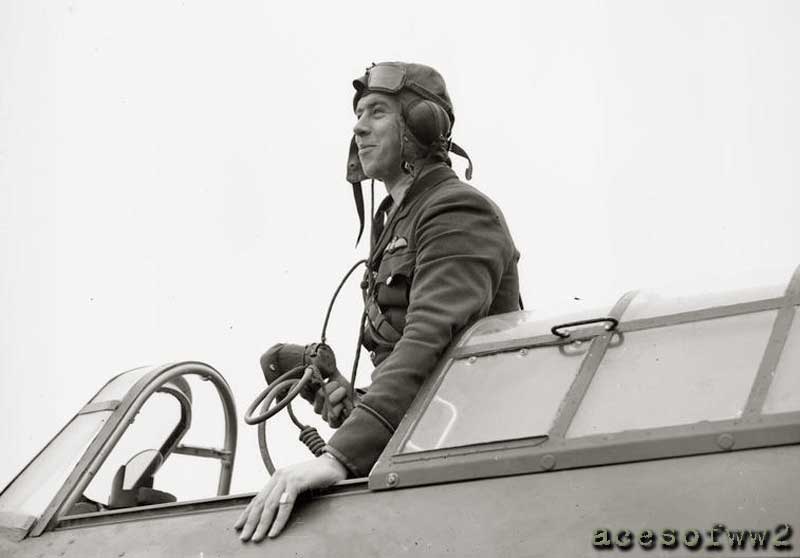
Victories Include :
| 8 Nov 1939 23 Nov 1939 2 Mar 1940 26 Mar 1940 23 Apr 1940 10 May 1940 11 May 1940 12 May 1940 14 May 1940 15 May 1940 17 May 1940 19 May 1940 25 May 1940 26 May 1940 27 May 1940 5 June 1940 |
one Do17 one Do17 one Me109 two Me109 one Me110 one Do17 one Do17 one Me110 one Hs126 one Me109 one Me110 one Me109 one Me110 one Ju88 one Me110 one Do215 one Do17 one Hs126 one Do17 one Me109 |
destroyed destroyed destroyed destroyed (Ace) damaged destroyed destroyed & unconfirmed destroyed destroyed unconfirmed destroyed & unconfirmed destroyed, destroyed & destroyed destroyed destroyed destroyed destroyed (damaged?) |
17 - 16 / 3 / 2 - 1
The 3 unconfirmed are seen in the probable spot
Score from Aces High 2nd Ed. [Shores & Williams]
_________________________________________________
YOUTH ALWAYS PAYS THE PRICE
1 July 1940 - "Cobber" Kain has paid the price that youth is called upon to pay for war.
The handsome, fearless young New Zealander flying officer who became the first British ace of the present war has given his last full measure of devotion to the cause which he believed was right. In doing so he put aside all the plans of life, plans which youth has a right to make, expecting realization. Only last April he had announced his engagement, but then came May and the invasion of Belgium and the bombings and the battles above the clouds — and death.
It is the old story of war. It was told over and over again in the World war. It is the story of Allan Seeger and Rupert Brooke and Joyce Kilmer and Quentin Roosevelt and millions of other young men who died on the field of battle. It is a story which American statesmen and American citizens should ponder gravely when they are tempted to think of war as an expediency.
_________________________________________________
"Cobber" Would Have Been Proud of Her
LONDON, 17 August 1940 — With a courage worthy of the brave man she loved, the sweetheart of Flying Officer "Cobber" Kain, D.F.C. killed on active service in June — stood before a crowd of thousands in Manchester recently to carry out a promise he had made.
She was 20-years-old Miss Joyce Phillips, of Mollington, Cheshire. "Cobber" had promised to hand over Colors to the 17th Squadron of the Manchester City Air Cadet Corps.
Mrs. Kain and her daughter Judy watched the ceremony from the grandstand.
The Colors were dedicated to "Cobber." Men of the R.A.F. spoke proudly of his skill and courage. Air Commodore R. H. Dobson introduced Miss Phillips to the squadron leaders on parade.
Then she handed over the Colors and took the salute at the march past. She stood at attention, chin up, eyes shining.
"Cobber" would have been proud of her.
_________________________________________________
BRITISH USE TEAM WORK, ACES OBSCURE
Many Planes Downed Without Flier Receiving Credit
FRIDAY, DECEMBER 13, 1940 - By JOHN A. PARRIS, United Press Staff Correspondent. |
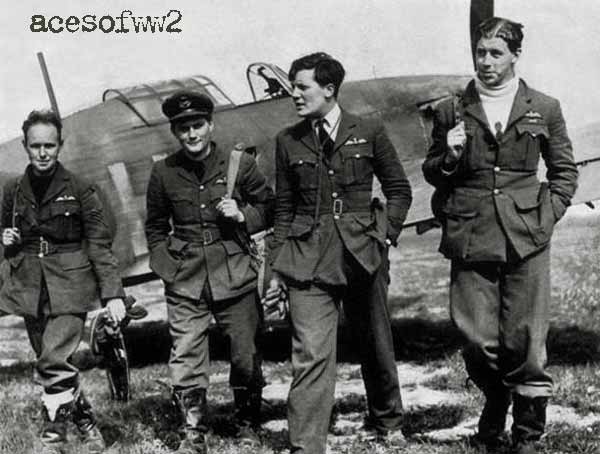 Lionel Pilkington, Ginger Paul, Fanny Orton & Cobber Kain of 73 Squadron. |
The highest bag of enemy planes thus far announced is 22 claimed by Eric Stanley Lock, a 24-year-old pilot officer. For bomber pilots there is acting squadron leader Duncan Stuart MacDonald, who since last September has participated in 81 "missions" against Germany.
Post-war records probably will reveal dozens of Royal Air Force pilots with a legitimate claim to be called "ace", but as one "veteran" of 23 said, "What the hell! We are all in it together."
Work In Teams
The aces of the 1940 squadrons — bomber and fighter — are not men. They are youngsters who work, in teams. The pilots who fly 400-mile-an-hour Spitfires — which replace the lightweight old Se-Fives of World War days, are anonymous team workers who rely on safety and the effectiveness of fighting together.
Bishop, Ball, Richthofen, Guynameyer and Rickenbacker had only a couple of low-rate machine guns as armament. They were up against small numbers of planes similarly armed, They fought at low speed over a comparatively small area, embracing the front lines.
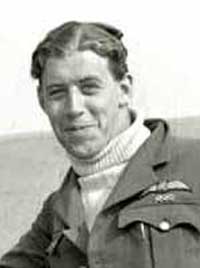 Despite the fact that the British Air Ministry says there will be no British Air Aces in this war, the late Cobber Kain, above, came mighty close to being one. |
The man who rides a bomber or fighter into battle today is getting into something which extends six miles up and several hundred miles in every other direction. He is up against machines carrying small cannon and a concentration of machine gun fire sufficient to chew a plane to pieces in the space of two or three seconds. With the exception of the "Night Hawk" bomber pilot who files a lone plane the watchword in the KAF trade is "teamwork." Converge Fire Not Credited |
_________________________________________________
Squadrons Up
When war came, the Royal Air Force dispatched two of its squadrons to France. The deeds of these fliers were forgotten in the thin obscurity of official communiqués, while war correspondents, bursting with stories that couldn’t be told, filled their notebooks.
One of these war correspondents who saw drama and death in the skies each day was Noel Monks of the London Daily Mail. And the stories he could get past the censors he tells now in "Squadrons Up" (Whittlesey House).
The two squadrons, 1 and 73, were opposites in every respect save in performance, sometimes against odds of 60 to 1. Number 1 was the group that operated by teamwork, had the reputation of being a well drilled, well-disciplined squadron. Number 73, on the other hand was at the bottom of its class when it crossed the channel to a French base. Its fliers were individualists, and included the lad from "down under" who was to become, in nine months, the first and greatest ace of the war. He was Flying Officer E. J. (Cobber) Kain.
Monks lived with these youngsters, watched them go off on patrol and come back with bullet-riddled wings. Sometimes they didn't come back. He watched them age years in a few weeks; sometimes he took part in their celebrations. He was a witness to their triumph and their heartaches, their battles and their fun.
"Squadrons Up" is necessarily a story of heroes, for these were the fighters that took on any number of the enemy any time, any place under any and all conditions. Monks’ favorite hero - as he was with his own and the other squadron - was the young New Zealand pilot "Cobber" Kain, the laughing youngster who died just when life seemed to tempt him with so much. The official communique announced Kain had been killed in a flying accident. Monks reveals that he died because of a boyish impulse to show off just before he hopped off for England to an instructor’s job and his bride-to-be. The day before "Cobber" had downed his 25th German plane. Just one more "beat up," he promised his mates, but he never completed it. "Cobber" Kain crashed and was killed almost in front of the plane that was being warmed up to fly him home.
_________________________________________________
Back to --- New Zealand Aces --- |
Related Sites : |
_________________________________________________
Thanks go out to
The IWM for the photos & infos !
On these pages I use Hugh Halliday's extensive research which includes info from numerous sources; newspaper articles via the Canadian Museum of Civilization Corporation (CMCC); the Google News Archives; the London Gazette Archives and other sources both published and private.
|
Some content on this site is probably the property of acesofww2.com unless otherwise noted.
![]()

